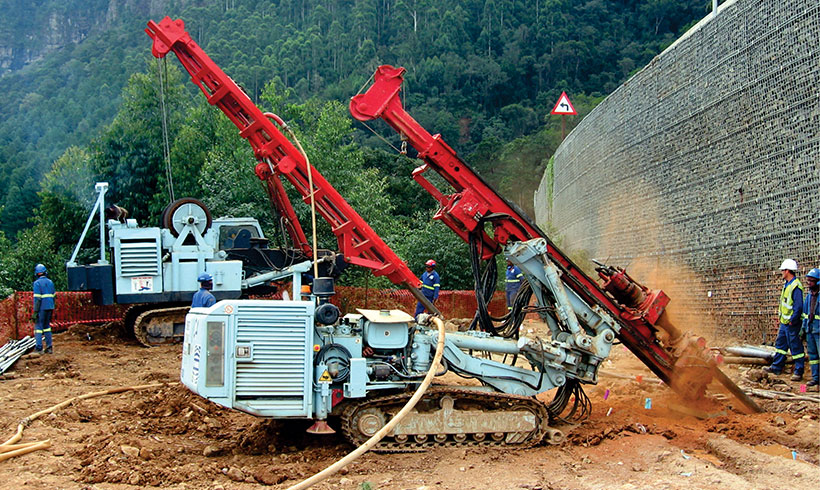What Does Geotechnical Engineering For Construction Projects Do?
Table of ContentsMore About Geotechnical Engineering For Construction ProjectsThe 6-Second Trick For Geotechnical Engineering For Construction ProjectsThe 5-Second Trick For Geotechnical Engineering For Construction ProjectsExamine This Report about Geotechnical Engineering For Construction ProjectsHow Geotechnical Engineering For Construction Projects can Save You Time, Stress, and Money.The Best Strategy To Use For Geotechnical Engineering For Construction ProjectsGeotechnical Engineering For Construction Projects Fundamentals Explained
and Kovacs, W. (1981 ), An Introduction to Geotechnical Design, Prentice-Hall, Inc. Deep Scan Technology (2023 ): Deep Check Tech discovers covert frameworks at the site of Denmark's highest building. "Geofrost Coring". GEOFROST. Obtained 20 November 2020. Han, Jie (2015 ). Principles and Method of Ground Enhancement. Wiley. ISBN 9781118421307. RAJU, V. R.Ground Improvement Technologies and Situation Histories. Singapore: Study Posting Providers. p. 809. ISBN978-981-08-3124-0. Ground Improvement Concepts And Applications In Asia. Pariseau, William G. (2011 ). Layout evaluation in rock auto mechanics. CRC Press. Hegde, A.M. and Palsule P (Geotechnical Engineering for Construction Projects).S. (2020 ), Efficiency of Geosynthetics Reinforced Subgrade Subjected to Repeated Automobile Plenties: Experimental and Mathematical Research Studies.
Cengage Understanding, Stamford, 666 p. Atkinson, J., 2007. The auto mechanics of dirts and structures. The Observational Technique in ground engineering principles and applications.
Getting The Geotechnical Engineering For Construction Projects To Work
Research laboratory and field testing plays an important duty in this procedure. By drawing out examples from the planet's subsurface and using a suite of examinations, geotechnical engineers can forecast the behaviour of soil layers and evaluate their viability for various construction endeavours. The essence of geotechnical design in civil design can not be overemphasized, attributable to several aspects: The first action in any type of geotechnical research study entails identifying the dirt kind at the building and construction site.
Comprehending these qualities guarantees that just appropriate dirt kinds are picked for the growth, thus averting possible structural failures. The structure works as the bedrock of any kind of construction project. Selecting the ideal structure kind is a choice that depends upon the comprehensive analysis offered by geotechnical engineering. This guarantees the durability and stability of structures by accommodating the loads they will bear.

Geotechnical site investigation is a vital action in the planning and execution of any kind of construction task. It entails the collection and evaluation of data connected to the physical buildings of dirt and rock beneath a suggested construction site. This info is important for the design and building and construction of safe, stable, and lasting frameworks.
Geotechnical Engineering For Construction Projects Things To Know Before You Get This
In this blog, we will certainly delve into the importance of geotechnical site examination, its various elements, and exactly how it benefits building jobs. Geotechnical site examination, likewise called subsurface expedition, involves a collection of tasks focused on identifying the dirt, rock, and groundwater conditions at a building website. The primary goals are to recognize prospective geotechnical dangers, assess the engineering homes of subsurface materials, and supply referrals for the style and building of structures, preserving wall surfaces, and various other frameworks.
The desk study assists in identifying potential geotechnical problems and intending the subsequent fieldwork. This involves observing the topography, water drainage patterns, existing structures, plant life, and any type of indications of instability or disintegration.
Some Known Facts About Geotechnical Engineering For Construction Projects.
Shallow test pits are dug deep into to directly observe and example the dirt and rock. This method is valuable for researching the upper layers of the subsurface and identifying near-surface risks. Non-invasive geophysical approaches, such as seismic refraction, ground-penetrating radar (GPR), and electrical resistivity tomography (ERT), are used to map subsurface problems and identify anomalies.
Soil and rock examples collected during the field examination go through research laboratory screening to determine their physical and mechanical residential or commercial properties. Typical laboratory tests consist of grain dimension evaluation, Atterberg restrictions, compaction tests, triaxial shear tests, and loan consolidation tests. These tests offer important information for geotechnical analysis and style. The data collected from the desk research study, site reconnaissance, field investigation, and research laboratory testing are evaluated and interpreted to establish a thorough understanding of the subsurface conditions.
The main advantage of geotechnical website investigation is making certain the safety and security and security of frameworks. By recognizing the subsurface problems, engineers can develop foundations and other structural elements that can withstand the lots and ecological pressures they will certainly go through. This reduces the risk of negotiation, subsidence, and architectural failing.
How Geotechnical Engineering For Construction Projects can Save You Time, Stress, and Money.
For instance, understanding dirt qualities can direct the selection of excavation methods, dewatering techniques, and ground enhancement steps. This ensures effective and secure construction methods. Geotechnical website investigations are usually needed by building codes and guidelines. Sticking to these demands makes certain conformity with lawful and check safety standards, preventing possible lawful obligations and task delays.
This info is invaluable for project managers, designers, and contractors in establishing sensible routines, spending plans, and backup plans. Geotechnical Engineering for Construction Projects. Skyscraper in a Coastal AreaIn a seaside city, a skyscraper property building was intended on a site with thought loose sand deposits and a high water table. A detailed geotechnical investigation, including borehole drilling, CPT, and geophysical studies, was conducted
See This Report about Geotechnical Engineering For Construction Projects
Based on these searchings for, the foundation design was modified to consist of deep stack structures extending into stable strata, and ground improvement strategies, such as vibro-compaction, were applied to alleviate liquefaction risks. This proactive strategy made sure the safety and security of the building while staying clear of expensive post-construction removal. Facilities Growth on a Sloping TerrainA major framework project, entailing the building and construction of a highway and bridges, was intended on a hilly terrain with high slopes.

The Leaning Tower of Pisa (Italy), a renowned architectural wonder, is infamous for its unplanned tilt from considerable geotechnical concerns. The tower's structure was inadequately developed to take care of the soft, unsteady dirt underneath it, causing uneven negotiation and its distinct lean. Our world is populated with excellent infrastructure projectsfrom looming skyscrapers to sprawling bridgesall standing testament to the evolution of the numerous building tools and techniques readily available.
Geotechnical engineering is a customized field within civil engineering that concentrates on researching the habits of earth products. This branch dives deep into the groundinvestigating just how the soil, rock, and groundwater at a building and construction website can influenceand be affected bythe infrastructure that we set up on and right browse around these guys into them. Before a single brick is laid or a concrete foundation poured, geotechnical engineers probe right into the earthgathering essential information about the site's soil make-up, rock framework, and groundwater degrees.
The smart Trick of Geotechnical Engineering For Construction Projects That Nobody is Discussing

is a device utilized to examine the stability and load-bearing capability of stacks during setup, leveraging the concept of wave proliferation. It enhances building effectiveness by offering real-time examinations, hence making certain risk-free and effective heap foundations. Among the functional applications of geotechnical engineering involves deciding and implementing the ideal approaches for foundation construction.
Load driving stands for more than the plain act of inserting structural components right into the ground. However, it is a meticulously coordinated process of moving a structure's load past the less stable soil layers better to the surfacedown to the a lot more significant strata that lie beneath. When it comes to heap driving, take into consideration exactly how geotechnical designers skillfully use this strategy to equally disperse the structure's weight.